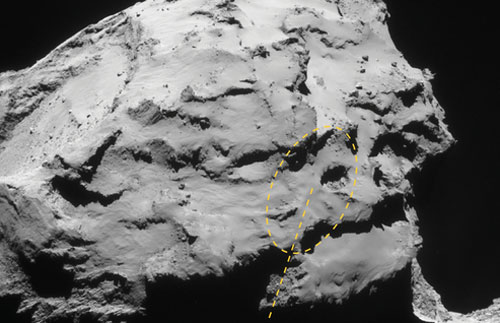Flash Physics is our daily pick of the latest need-to-know developments from the global physics community selected by Physics World‘s team of editors and reporters

ESA marks the spot for Rosetta’s final, fiery descent
Marking the end of their two-year-long observational mission, the European Space Agency has revealed that its Rosetta orbiter will make a controlled crash into the Ma’at region of Comet 67P/Churyumov–Gerasimenko on 30 September. The space-bound observatory will be taking data during its final descent, as the target area contains several “active pits” from which a number of the comet’s dust jets originate. The Rosetta team says that some of the pit walls also exhibit intriguing metre-sized lumpy structures called ‘goosebumps’, which could be the signatures of early cometesimals that agglomerated to create the comet in the early phases of solar system formation. Read more about the Rosetta mission in “Rendezvous with a comet” – a feature penned by team-member Matt Taylor.
Atomic clocks in UK and France linked by optical fibre
Atomic clocks at the UK’s National Physical Laboratory near London and two Paris research labs – LNE-SYRTE and Laboratoire de Physique des Lasers – are now connected by a 800 km fibre link that passes through the Channel Tunnel and has 10 signal amplifiers along its length. The link will be used to compare the timekeeping of the clocks in order to develop a new definition of the second. Clocks at LNE-SYRTE are already connected to atomic clocks in Germany via a 1400 km fibre link that runs to the PTB Braunschweig laboratory.

Fermi telescope is our best bet for axion discovery
Evidence for axions – hypothetical particles that could constitute dark matter – could be spotted by the Fermi Large Area Telescope (LAT), according to physicists in Sweden, the US and Italy. Manuel Meyer of Stockholm University and colleagues reckon that the space telescope could be used to search for axions that could be created in some supernovae. These particles would then interact with the magnetic field of the Milky Way to create gamma rays that could be detected by Fermi LAT. Meyer and colleagues believe that such a search would be more sensitive to the existence of axions than proposed next-generation laboratory experiments. The proposal is described in a preprint on arXiv.
LHC’s MoEDAL fails to find magnetic monopoles
Physicists working on the MoEDAL experiment – which runs on the Large Hadron Collider (LHC) at CERN – have failed to find evidence for the existence of magnetic monopoles after analysing data acquired during the first run of the LHC. First predicted by Paul Dirac in the 1930s, magnetic monopoles are hypothetical entities that have never been observed as distinct particles. MoEDAL uses several different techniques to detect monopoles, which could be created in high energy proton–proton collisions at the LHC. First-run data were collected using a prototype version of the detector. The team is now analysing data obtained during a later run of the LHC in 2015, when a fully fledged version of MoEDAL was used. The results are described in a preprint on arXiv.
- You can find all our daily Flash Physics posts in the website’s news section, as well as on Twitter and Facebook using #FlashPhysics. Tune in to physicsworld.com later today to read the latest news story on squeezed light.



